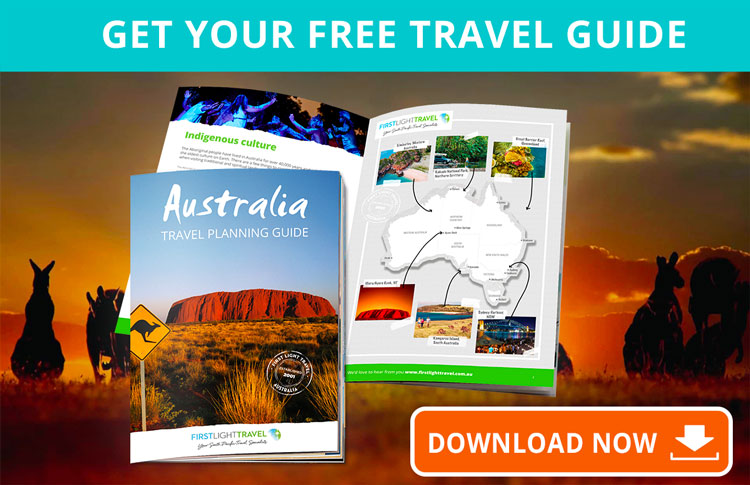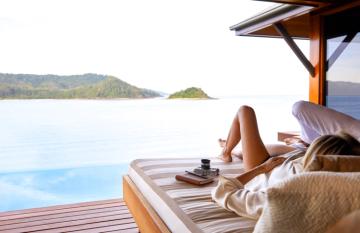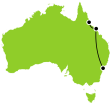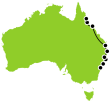
Travelling in and around Sydney is easy, thanks to the city’s excellent transport infrastructure. Whether you want to hire a car and drive yourself, get your head around the public transport, or figure out how long it takes to fly between Sydney and other Australian cities, you’re in the right place. We’ve put together a guide to the best ways to get around Sydney, as well as tips on how to take day trips to surrounding Sydney attractions, and information on travelling to and from Sydney within Australia. Let’s get started!
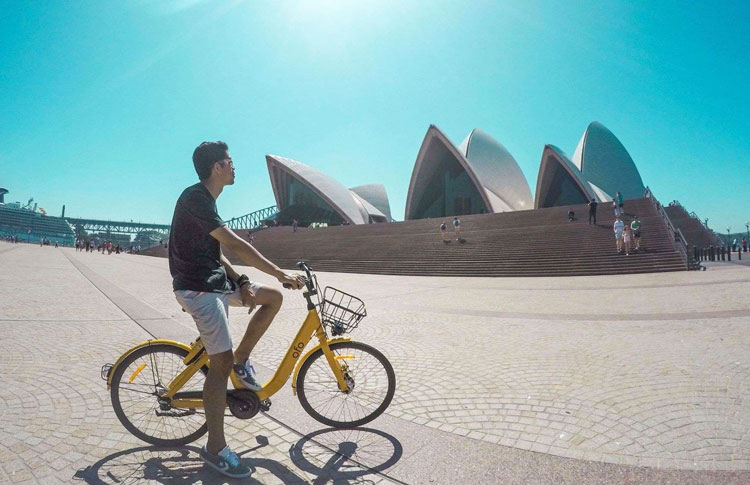
How to get around Sydney: practical information
Sydney is a huge city, with over 5 million inhabitants and a sprawling metropolitan area. However, as a very modern city, it has good transport infrastructure, and it’s easy to get around by a range of different options.
Driving in Sydney
Sydney, like most of Australia, is a very car-friendly city, with a good network of paid and public highways, multiple-lane roadways, and excellent road signage across the city.
Hiring a car in Sydney
There are hundreds of car hire companies in Sydney, both at the airport and around the city. These include global brands like Avis, Thrifty, Hertz, and Budget.
Doin’ it for the kids – Car seats are compulsory by Australian law, so be sure the rental company provides them if you’re travelling with kids.
A few simple rules – it’s pretty straightforward for foreign visitors to hire a car in Sydney, provided they are over 21 years old and have a valid driver’s license (from any country).
Taxis and rideshares in Sydney
For those who don’t want to hire a car, it’s very easy to get around Sydney by taxi or rideshare. There is a huge fleet of official metered taxis, which you can either hail, call in advance, or order through mobile apps with companies like Manly Cabs and Premier Cabs.
Alternatively, international rideshare apps such as China’s DiDi, India’s Ola, and California’s Uber are totally legal and incredibly popular in Sydney, so you shouldn’t have any trouble finding a ride whichever one you choose.
BUT WHAT IF I DON’T WANT TO BE IN A CAR AT ALL?
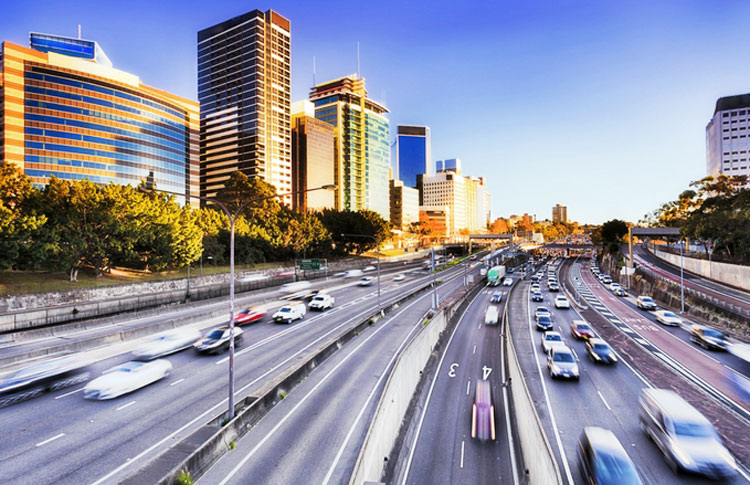
Taking public transport in Sydney
It’s certainly not necessary to drive in Sydney, as the city has a great, easy-to-use, accessible public transport network comprising bus, metro, train, and ferry routes.
Trains
Train Trains are the fastest and most efficient way to get around greater Sydney.
Sydney has nine different train lines, servicing pretty much all parts of the city including the North Shore, western suburbs, eastern beaches, and south as far as Campbelltown and Cronulla.
The main train station in Sydney is Sydney Central, between Chinatown and Surry Hills at the southern end of the CBD (Central Business District).
Trains run frequently on all lines throughout the day, seven days a week.
The City Circle line in the CBD may be the most useful line for visitors and tourists. This operates in a loop around the city centre, stopping at convenient stations for sight-seeing including Circular Quay (for ferries, the Opera House, the Harbour Bridge, and the Rocks) and Town Hall (for Darling Harbour).
Metro
The fully automated Sydney metro system is still under development and its current range is pretty limited, running only in the southern end of the CBD and the inner western suburbs. However, if this is where you’re staying, it can be a very quick and helpful way to get to the city centre and back!
Bus
The bus network offers the most comprehensive number of services in Sydney’s public transport network. It is particularly useful for visitors who aren’t staying near a main station or those who are looking to explore the beachside and outer suburbs.
Some of the most useful routes for visitors to know are:
The 333, 380 and 381 services from Circular Quay to Bondi
The B-Line buses running from Wynyard station in the CBD all the way up through the northern beaches to Mona Vale
For a truly scenic option, the L90 runs all the way from the city centre up to Palm Beach
Boat and Ferry
Arguably the real stars of the city’s public transport network, Sydney’s public ferry services offer something truly unique to visitors – in addition to being useful commuter services, they double as attractions in themselves thanks to the superb views you get along the way!
Sydney has eight public ferry routes. Some of the most popular ones departing from Circular Quay, which offer close-up views of the Sydney Opera House and Sydney Harbour Bridge, include:
F3 Parramatta River ferry service to the western suburbs via trendy Balmain
F7 to the smart inner harbourside suburb of Double Bay
F6 across Sydney Harbour to Cremorne Point and Mosman Bay on the Lower North Shore
F1 out through the headlands to the northern beaches at Manly
F8 around the western harbourside suburbs to Cockatoo Island
The Opal Card – your ticket to Sydney’s public transport network
All forms of public transport within Sydney, the Blue Mountains, and the Hunter Valley are part of the Opal Card network. This is a contactless ticket system that means you can simply tap on and tap off to use the buses, boats, or trains. No need to worry about finding the right change or buying tickets!
Opal Cards also offer significant savings and benefits:
They have capped daily and weekly fares, so you’ll never overpay
There are 30% discounts on Opal fares during weekends and public holidays
Children aged 5-14, and some high school students, can register for a cheaper youth fare card
The card is registered to your name, so even if it gets stolen or lost, you won’t lose your money as this can be transferred onto a new card
It’s wise for all visitors to pick up an Opal Card when they arrive in Sydney. But if you don’t have time, don’t fear – you can also tap on to pay at Opal card readers using contactless debit and credit cards. Although this means that you will be charged the full adult fare, and be sure to use the same card to tap on and off, otherwise you could be charged higher rates.
NEED TO KNOW MORE?
The official NSW Transport website has all the information you need regarding Sydney’s public transport and the Opal network.
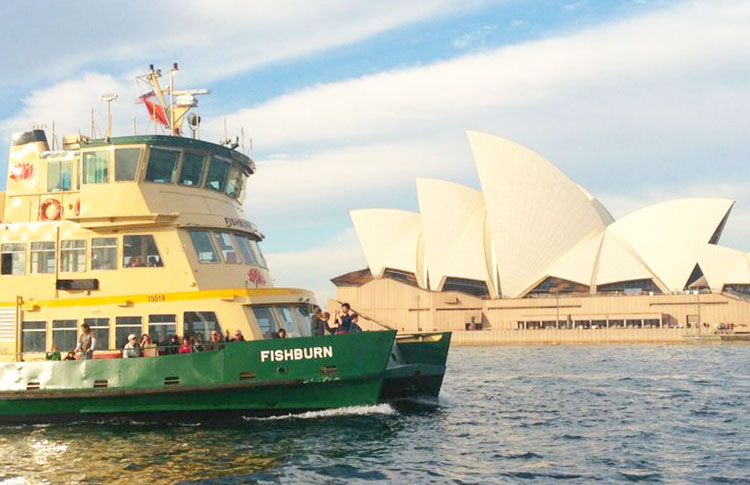
Sydney Harbour boat cruises and city day tours
Another option for getting around Sydney is to book a tour and leave it up to the experts. As well as getting you quickly from A to B, these are surefire ways to ensure you get to see all of Sydney’s main attractions, without having to figure out how to get there.
Boat Cruises – There’s a huge range of Sydney Harbour cruise options, from simple hour-long sight-seeing boat trips to lavish evening cocktail and dinner cruises. Companies like Captain Cook Cruises offer the full range.
Day Tours – Trying to see everything Sydney has to offer in one day is a big ask. But tour operators such as Sydney City Tours give fleeting visitors the best shot at it. They provide private transport, quick-entry access into attractions, and local insider tips, helping to fit as much into a day tour as possible.
Walking Tours – If you confine yourself to one area, it’s also possible to get around Sydney on foot. However, it’s best to have somebody to show you where to go, plus tell you interesting information and history along the way. For this, it’s hard to beat The Rocks Walking Tours, Australia’s oldest walking tour which tells the city’s history through sites around its most historic harbourside district.
- Hop On, Hop Off Bus – Big Bus Sydney offer full-day hop on, hop off bus tours that let you explore all of Sydney’s must-see attractions at your own pace. Some tours also include a harbour boat cruise and guided walking tour in the price.
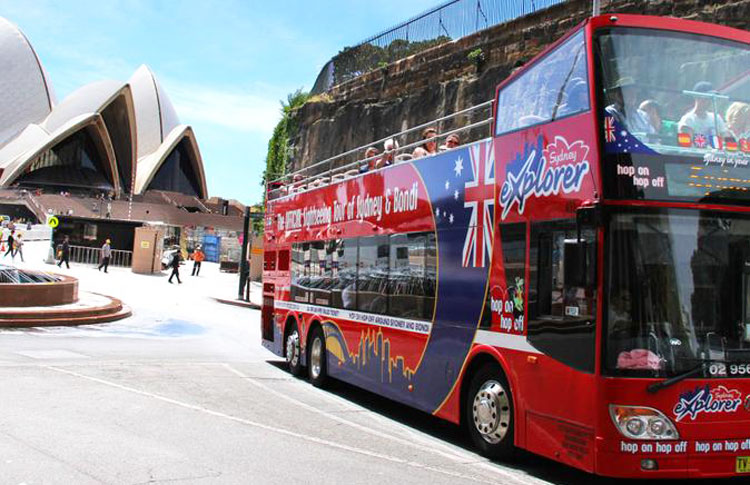
Attractions and day trips outside Sydney – how to get there
Some of Sydney’s most popular attractions aren’t located in the city, per se. But they are still incredibly easy to get to for a day trip:
Getting to the Blue Mountains from Sydney
The Blue Mountains are an iconic UNESCO World Heritage site full of breathtaking views and important cultural sites. Whichever mode of transport you choose, it’s easy to get to the beautiful Blue Mountains in under two hours from Sydney.
Driving to the Blue Mountains from Sydney
The M4 Western Motorway, which starts just west of Sydney CBD, runs through Parramatta and Penrith to Glenbrook, where it turns into the Great Western Highway and continues onto the Blue Mountain towns of Faulconbridge (one hour from the CBD), Katoomba (85 minutes from the CBD) and Blackheath (95 minutes from the CBD).
If you fancy a slightly slower, more picturesque route, try the Bell’s Line road. Starting in Richmond just north of the western suburbs, this route curls its way around hillsides, through tunnels, and over bridges within the Blue Mountains National Park as far as Mount Victoria, with beautiful viewpoints at every turn. It should take about 1 hour and 55 minutes total from central Sydney.
Taking the train to the Blue Mountains from Sydney
The brilliant Blue Mountains Line runs directly from Sydney Central to the heart of the Blue Mountains.
Services run at least every hour from early morning until midnight, stopping at all major Blue Mountains towns including Leura, Faulconridge, Katoomba, Springwood and Lithgow, as well as plenty of smaller towns and popular sight-seeing destinations.
For reference, the journey time from Sydney Central to Katoomba is around 2 hours and 12 minutes.
Getting around in the Blue Mountains
Roads in the Blue Mountains are well maintained, so having a hire car is a good option for getting around.
Alternatively, local coaches and bus lines run between Blue Mountains towns, or if you want to try and see it all, you can visit up to 29 Blue Mountains sights on the hop on, hop off Explorer Bus.
Getting to the Hunter Valley from Sydney
The Hunter Valley is a beautiful region renowned for its wines, beautiful landscapes, and quirky local towns. It makes for an easy day trip from Sydney.
Driving to the Hunter Valley from Sydney
It takes under two hours to drive to the Hunter Valley from Sydney’s CBD.
For the fastest driving route, cross the Sydney Harbour Bridge and take the A1/Pacific Highway as far as Wahroonga, then turn onto the M1/Pacific Motorway.
You can then either follow the M1 as far as Freeman’s Drive and turn onto the B82, taking it all the way through to Cessnock (1 hour 50 minutes from central Sydney). Or, turn off the M1 onto Tourist Drive 33 at Peats Ridge, then follow this beautiful road through the mountains until Wollombi (1 hour 45 minutes).
Taking the train from Sydney to the Hunter Valley
Travellers have two options for getting to the Hunter Valley from Sydney by train:
The North West Line goes straight from Sydney Central to Maitland and Singleton in the Hunter Valley, taking around three hours.
Alternatively, the Hunter Line runs from Newcastle through the Hunter Valley, stopping at many small towns. It takes about the same time as the North West Line to reach the Blue Mountains, taking around three hours to the likes of Branxton, Thornton, or Tarro (including changeover time in Newcastle).
Getting to the South Coast from Sydney
The NSW South Coast is packed with stunning beaches, dramatic scenery, and pristine wildlife reserves. It’s another good option for day trips from Sydney.
Driving to the South Coast from Sydney
Starting just south of the city, the Grand Pacific Drive is one of Australia’s most beautiful stretches of road, winding through the Royal National Park, hugging some stunning coastline, and crossing the impressively balanced Seacliff Bridge through Wollongong to Shellharbour and Kiama.
The drive from central Sydney to Kiama takes around two hours. If you fancy spending more time in the South Coast, beautiful Jervis Bay is about another hour further on.
Taking the train to the South Coast from Sydney
The South Coast Line train runs regular services straight from Sydney Central station to Wollongong, Shellharbour, Kiama and other South Coast destinations, all the way to Bomaderry station near Nowra.
Trains depart from Central station approximately every hour, from early morning until late at night, seven days a week, with departures from Bondi Junction on the weekends.
Travelling between Sydney and other major Australian cities
Australia is a huge country but, as its largest city, Sydney is well connected to the rest of it. Therefore, it’s easy to travel between Sydney and other major cities by a number of transport options.
Flying between Sydney and other Australian cities
There are hundreds of daily direct flights between Sydney and other major Australian cities. To give you an approximate idea of flight times:
Sydney<>Canberra: 55 minutes
Sydney<>Melbourne: 1 hour and 25 minutes
Sydney<>Brisbane: 1 hour and 35 minutes
Sydney<>Adelaide: 1 hour and 50 minutes
Sydney<>Hobart: 1 hour and 50 minutes
Sydney<>Perth: 4 hours and 10 minutes
Sydney<>Darwin: 4 hours and 25 minutes
These flights are operated by a range of commercial carriers, including Australia’s three biggest domestic airlines:
Qantas – Australia’s national carrier and the world’s third-oldest airline flies to 41 destinations in Australia.
Virgin Australia – despite only launching in 1999 as Virgin Blue, Virgin Australia is the country’s second-biggest airline, serving 29 domestic destinations.
Jetstar – A popular low-cost airline and a subsidiary of Qantas, Jetstar flies to 19 domestic destinations and is the third-biggest domestic Australian airline.
Tigerair and Rex are other, smaller airlines who operate domestic flights around Australia from Sydney.
Trains between Sydney and other cities
Trains across Australia offer an enjoyable alternative to flying. You get to enjoy the view, don’t have to worry about travelling to and checking in at the airport, there are onboard buffet meal and snack services, and the trains take you straight from city centre to city centre.
Sydney <> Canberra by train
The XPLorer train operates three journeys a day in each direction between Sydney Central and Canberra’s Kingston railway station, with early morning, midday, and early evening departures.
This journey passes through gorgeous landscapes of the NSW Southern Highlands and takes around four hours.
Sydney <> Melbourne by train
NSW TrainLink’s high-speed XPT (eXpress Passenger Trains) service connects Sydney Central with Melbourne’s Southern Cross station in about 11 hours, twice daily in each direction.
There are both daytime and overnight services, and you can book 2-berth sleeper compartments for the night trains. Hot meals are available to order on board or in advance.
Sydney <> Brisbane by train
The XPT service also goes between Sydney and Brisbane, taking about 14 hours.
There is one journey each day, travelling towards Sydney during the day, and towards Brisbane overnight.
The train leaves daily from Sydney Central in the mid-afternoon and arrives into Brisbane Roma Street (very) early in the morning. In the other direction, it departs from Brisbane Roma Street in the morning and arrives at Sydney Central late at night.
Sydney <> Adelaide <> Perth by train: The Indian Pacific
Visitors looking for a real experience – and a premium one at that – might be interested in the 3-day train journey between Sydney and Perth, known as the Indian Pacific (for travelling from one ocean to the other).
This epic 72-hour, 4,343-kilometre journey is done in style, and it certainly isn’t on the budget traveller’s list. But it provides a truly unique experience.
The service operates once a week throughout the year, and twice a week during summer and holidays. The train stops for a few hours along the way, in Broken Hill, Adelaide (roughly 24 hours from Sydney), Cook, and Kalgoorlie to stretch your legs. On board you get to enjoy a private room with a cosy bed, a full-service restaurant, and a comfortable lounge area as you watch the vast Australian wilderness whizz by.
For more information and ticket bookings, the Melbourne, Brisbane, and Canberra trains are operated by NSW TrainLink, while Journey Beyond operate the train between Sydney, Adelaide, and Perth. You can also find more information about all journeys on the Australian Rail Maps website.
Driving between cities in Australia
Driving between cities in Australia can be a rewarding experience, providing total freedom to stop and visit small towns and discover places that very few travellers ever get to visit.
However, Australia is an enormous country, so don’t take driving for granted – and bear in mind that when signs say things like ‘No Fuel or Services for the next 400 km’, they really mean it (in other words, ALWAYS have spare petrol and plenty and plenty of water!).
That said, this will only really be a problem if you plan to drive cross-country to Sydney from the likes of Perth (4,000 km, 42 hours driving time) or Darwin (4,000 km, 44 hours driving time) – or in the other direction – where you will have to drive through loooooong stretches of desert. The cross-country drive is an experience of a lifetime, but perhaps not the best option for those visiting Sydney for a short time.
On the other hand, Adelaide to Sydney is an easy, three-hour drive, and Newcastle to Sydney takes only two hours. The 9-10 hour drive to Sydney from either Melbourne or Brisbane can also be both manageable and rewarding for visitors on short trips.
There are plenty of towns, attractions, and services along the way. And the highways are wide and excellently maintained, so driving is a breeze. From Brisbane, Coffs Harbour (5 hours 30 minutes north of Sydney) and Byron Bay (2 hours south of Brisbane) are especially popular stop-offs.
Long-distance buses to and from Sydney
For those who don’t mind long bus journeys, Greyhound Australia offer cheap, regular services to Sydney from Brisbane (17 hours) and Melbourne (12 hours), and three-hour services from Canberra.

A final word...
To sum up, there are lots of different ways to get around Sydney – whether that means getting around within the city, getting out of the city for a day trip, or getting to and from Sydney from other Australian cities:
Within Sydney: order an Uber or get yourself an Opal Card and enjoy Sydney’s excellent public transport system
Outside Sydney: easily get from Sydney to the Blue Mountains, Hunter Valley, or the South Coast for a great day trip
Around Australia: whether by plane, car, bus, or train, all roads in Australia lead to Sydney, so you have plenty of options for getting around
Need a hand planning your Sydney vacation?
So, now that you have a fair idea how to travel in and around Sydney, why not start looking at potential ideas and itineraries for a trip to Sydney?
For any questions or queries, First Light Travel’s professional travel planning advice team is here to help. You can call or get in touch with them online.
It’s totally free, with no obligation, so there’s very little to lose – except the chance of missing out on making the most of an unforgettable Australian holiday!
Recent Posts
Blog Categories
Blog archives
- March 2025 (1)
- November 2024 (1)
- October 2024 (1)
- September 2024 (8)
- June 2024 (4)
- May 2024 (2)
- April 2024 (2)
- March 2024 (13)
- February 2024 (3)
- January 2024 (5)
- December 2023 (6)
- November 2023 (4)
- October 2023 (11)
- September 2023 (2)
- August 2023 (6)
- July 2023 (2)
- June 2023 (17)
- May 2023 (3)
- April 2023 (5)
- March 2023 (8)
- February 2023 (9)
- January 2023 (12)
- December 2022 (9)
- November 2022 (12)
- October 2022 (12)
- September 2022 (12)
- August 2022 (6)
- July 2022 (9)
- June 2022 (7)
- May 2022 (3)
- April 2022 (4)
- March 2022 (6)
- February 2022 (1)
- January 2022 (4)
- December 2021 (2)
- November 2021 (3)
- October 2021 (1)
- September 2021 (4)
- August 2021 (10)
- July 2021 (13)
- June 2021 (6)
- April 2021 (2)
- March 2021 (2)
- February 2021 (1)
- January 2021 (1)
- December 2020 (2)
- November 2020 (3)
- October 2020 (2)
- September 2020 (1)
- August 2020 (1)
- July 2020 (1)
- June 2020 (1)
- May 2020 (1)
- March 2020 (1)
- February 2020 (2)
- January 2020 (4)
- December 2019 (2)
- November 2019 (1)
- October 2019 (1)
- September 2019 (5)
- August 2019 (1)
- July 2019 (5)
- June 2019 (1)
- May 2019 (1)
- April 2019 (1)
- March 2019 (1)
- February 2019 (1)
- January 2019 (1)
- December 2018 (1)
- October 2018 (1)
- May 2018 (1)
- February 2018 (1)
- December 2017 (1)
- October 2017 (1)
- June 2017 (1)
- May 2017 (1)
- February 2017 (1)
- January 2017 (1)
- September 2016 (1)
- August 2016 (2)
- July 2016 (1)
- June 2016 (1)
- May 2016 (1)
- April 2016 (1)
- December 2015 (1)


